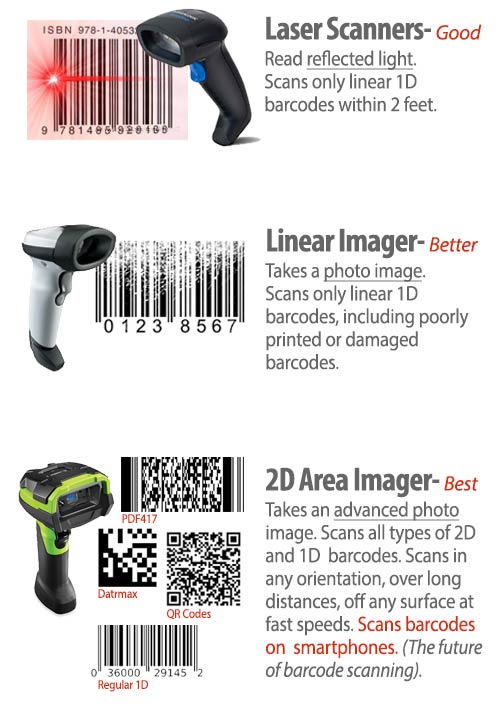Mastering Barcode Scanners: An Insight Into Their Workings, Features, And Uses
Introduction
If you've ever shopped at a supermarket, you've probably encountered a barcode scanner. But what exactly are they, how do they function, why have they become so important in today's economy, and which one is right for your business? This comprehensive guide aims to answer these questions and provide a deeper understanding of barcodes scanners, including their real-world applications and their evolution over time.
What Are Barcode Scanners?
Barcode scanners, often spotted at retail checkout counters, are versatile electronic instruments with the capacity to read and translate universal barcodes. Let's dive deeper into their defining aspects:
- Identity: These are colloquially known as point of sale (POS) scanners, integral to myriad business operations worldwide.
- Composition: Barcode scanners comprise three primary components - a light source, a lens to capture light patterns, and a sensor to convert this optical data into electrical signals.
- Functions: The task of barcode scanners is to interpret the encoded data in barcodes, represented by the variance in width and spacing amongst parallel lines. They then convert this data into a digital format for further processing.
- End Goal: Following the successful scan and conversion, the digital data is forwarded to the connected computer system, linking the scanned information back to the real-world entity it represents. Thus, barcode scanners act as vital links between physical products and digital data.
How Do Barcode Scanners Work?
Unraveling the Technology Utilized by Barcode Scanners
In essence, barcode scanners operate by employing a beam of light to read barcodes. Let's delve into the details:
- Utilize Light Energy: The scanners project a beam of light onto the barcode.
- Dark and Light Contrast: The dark bars on a barcode absorb the light and the white spaces reflect it.
- Absorption and Reflection: The scanner measures the light reflected back. The difference between light reflection and absorption translates into data.
The Process of Barcode Reading and Decoding
The procedure of reading and decoding that barcode scanners follow comprises numerous steps:
1. Illumination: The scanner first illuminates the barcode using a light source.
2. Light Capture: Dark parts of the barcode absorb the light and white areas reflect it back into the light-sensitive photodiode located within the scanner.
3. Analog to Digital Conversion: The photodiode generates corresponding electrical signals representing the light pattern, which are then converted to a digital format.
4. Decoding: The scanner's decoder processes the digital signal, interpreting the barcode's data and formatting it into a form understandable by the receiving computer.
5. Data Transmission: The processed data is then forwarded to a computer.
Thus, barcode scanners embody a perfect synthesis of optics, electronics, and data processing, playing an integral role in enhancing operational efficiency across various sectors.
Why are Barcode Scanners Essential in Today's Economy?
In the rapidly evolving digital economy, barcode scanners have emerged as a game-changing tool across diverse industries. Swift, precise, and error-free, they deliver a myriad of benefits that enhance a broad spectrum of operations. Let's unpack the reasons why barcode scanners are indispensable in today's economic landscape:
• Efficiency and Speed: Barcode scanners provide swift and effortless data capture, accelerating a wide range of business operations.
• Precision: Barcode scanners significantly reduce the possibility of human error. They ensure accurate data collection, eliminating the inaccuracies of manual entry.
• Operational Streamlining: Barcode scanners dramatically improve business efficiency - from inventory control to checkout processes in retail stores. It provides real-time tracking and information, leading to smarter decision-making.
• Impact across Industries:
- Retail: Barcode scanners enable quick checkout procedures, precise pricing, and effective inventory management, enhancing customer experience.
- Logistics & Transportation: They are pivotal in tracking packages, thereby boosting service to customers and resource allocation.
- Healthcare: Barcode scanners contribute to patient safety by ensuring accurate patient identification, medication tracking, and reducing medical errors.
Understanding the value of barcode scanners in the contemporary economy can assist organizations in leveraging this technology to its full potential.
Different Types of Barcode Scanners: Which One is Best for Your Business?
In the world of barcode scanners, understanding the distinctions between different types is crucial to determining which one aligns best with your business needs. Here, we establish a comparative analysis between Laser and CCD barcode scanners and delve into the exclusive features of some prevalent barcode scanners.
Laser Versus CCD Barcode Scanners: An In-depth Comparative Study
Laser and CCD (Charged Coupled Device) are two major types of barcode scanners, each exhibiting its unique features:
- Laser Barcode Scanners: These scanners utilize a laser beam as the light source, permitting longer read distances and rendering greater precision. Some key points about laser scanners are:
• High accuracy: Ideal for scanning from long distances.
• Versatility: Can read barcodes from any flat surface.

• Drawback: Tend to be pricier than CCD scanners.
- CCD Barcode Scanners: Also referred to as LED scanners, CCD scanners harness hundreds of minuscule light sensors for scanning. Here's what you need to know about CCD scanners:
• Cost-effective: Usually less expensive than their laser counterparts.
• High-speed scanning: Excellent for short distance scanning with high speed.
• Drawback: Limited read distances compared to laser scanners.
Highlighting the Special Features of Popular Barcode Scanner Varieties
Here, we pinpoint some distinguishing features of popular types of barcode scanners:
- Flatbed Scanners: Widely employed in retail segments, flatbed scanners come equipped with a spacious reading window, offering lightning-fast scanning and robust durability.
- Handheld Scanners: Emphasizing user convenience and mobility, handheld scanners are perfect for businesses that require regular movement during scanning operations.
- Wireless Scanners: These scanners provide enhanced flexibility by eliminating the need for any wired connections. This makes them a terrific option for large-sized stores managing extensive inventories.
- Presentation Scanners: Ideal for businesses with high-volume scanning needs, presentation scanners enable hands-free operations, unburdening the scanning process.
In conclusion, the selection of a barcode scanner should consider various factors such as reading distance requirement, working environment, and budget constraints. By understanding the pros and cons, as well as the unique features of each type, businesses can make informed decisions on which barcode scanner aligns best with their operations.
Real-world Applications of Barcode Scanners
Barcode scanners have found their applications across various sectors, redefining operational efficiency and boosting accuracy. Here's a breakdown of their applications in different industries:
1. Retail: This is the industry where barcode scanners are predominantly used. They not only expedite the checkout process but also help keep the inventory in check. For instance, according to a study by Motorola Solutions, using barcode scanners can reduce inventory errors by as much as 41%.
2. Healthcare: In an industry where accuracy is paramount, barcode scanners have a crucial role to play. They ensure patient safety through precise patient identification and medication tracking. The U.S. Food and Drug Administration (FDA) advocates the use of barcode scanners in healthcare, aiming to help prevent medication errors.

3. Logistics: Delivering packages on time with no mix-ups is the ultimate aim of any logistics company. Barcode scanners help track packages more effectively, improving customer service, and reducing delivery errors. UPS, a renowned logistics company, reportedly scans over 1.3 billion packages per day!
4. Manufacturing: Barcode scanners significantly improve process control and product traceability in manufacturing units. They enable easy tracking and management of parts inventory, work in process, and quality assurance, ensuring optimized production processes. Reports reveal that barcode scanners can increase productivity in the manufacturing sector by up to 50%.
Conclusion
Whether you're in retail, logistics, healthcare, or manufacturing, understanding the working, features, and uses of barcode scanners can significantly enhance your business operations. With numerous options available, a clear comprehension of your specific requirements can assist in choosing the right scanner, serving as an essential tool to maintain efficiency and accuracy.
Related FAQs about what are barcode scanners
How do Barcode Scanners Benefit Businesses?
Barcode scanners enhance business operations by providing swift, accurate data capture, reducing human errors, and streamlining processes like inventory control. They also enable real-time tracking and information, aiding smart, data-driven decision-making.
What are Some Limitations of Using Barcode Scanners?
While barcode scanners offer numerous benefits, they have certain limitations. The cost can be prohibitive for small businesses. Additionally, the scanner's reach and capacity to read damaged or poorly printed barcodes can sometimes be restricted.
How has the use of Barcode Scanners Evolved over Time?
Initially limited to retail checkouts, barcode scanners' use has evolved to encompass diverse sectors like logistics, healthcare, and manufacturing. Advancements in technology have introduced wireless and mobile scanners, enhancing flexibility and mobility.


